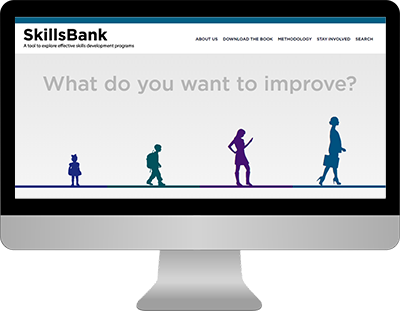Over the last 25 years, Latin America and the Caribbean has boosted efforts in primary education to the point that it is nearly universal, with three out of four students finishing primary school on time. But educational quality for very young children in the region still lags far behind that of developed countries. It even trails countries of similar levels of development in other parts of the world, despite similar levels of spending.
Throwing money at the problem is not going to make the difference. The key is spending money better, a central theme of our recent flagship study, Learning Better: Public Policy for Skills Development. It is finding the most cost-effective solutions to boost children’s performance and setting them up to compete on the world stage as adults.
One principle resource is our online SkillsBank, which summarizes results from educational interventions around the world and includes studies that were reviewed and support our report’s conclusions.
We look at 20 different types of interventions for improving mathematics, reading and writing from the SkillsBank. We focus only on studies that present credible evidence of impacts, i.e., where those estimated impacts are based on experimental trials or quasi-experimental ones in which children in the control group did not receive the intervention but are similar to those who did.
We also look at the tricky issue of the costs of interventions, which are not reported in the vast majority of studies. Using information on the necessary inputs per student of each intervention, we price them according to their relevant costs in Colombia in 2015, a country whose GDP per capita in purchasing power parity (PPP) is close to the Latin American and Caribbean average.
Our findings are surprising and not what might be expected from media reports and at least some of the academic literature.
Reducing class size has small impacts on learning
Much hope in recent years, for example, has been placed on shrinking class size, a seemingly obvious solution that would allow teachers to give more individualized attention to each student. In our review, however, we found that reducing the number of students in each class from 25 to 20 had an average impact of only 6 points, with very high costs in increased infrastructure and the additional recruitment of teachers. As a point of comparison, an average third grade student in the United States improves around 40 points during the course of the year. That means a 6-point increase is roughly a 15% improvement in learning.
Lengthening the school day from four to seven hours, as has been done in various parts of Latin America, is even less promising. On average, it increases learning by a mere 4 points. That despite the need to double the number of schools in what would inevitably be a highly costly reform.
Access the SkillsBank to find out what policies work |
Huge effects from tutoring
Not surprisingly, one-on-one tutoring can have magnificent effects. Given its laser-like focus on the individual, it can inject real dynamism into the learning process for flagging students, with an average learning improvement of 34 points. Comparing that to our 40-point standard for learning in a year, this is an astounding 80% increase. But hiring teachers for every struggling student is expensive. It could severely stretch the budget of a school system.
What about monetary versus non-monetary benefits? Is it better to offer cash for better performance or provide students with opportunities to build self-esteem and inspire them with the possibilities of a fulfilling life? For those with a more material frame of mind, the results may be disappointing.
We looked at various studies ranging from paying teachers in India according to the amount of days they showed up for school to providing teachers with bonuses for improved student performance. We also examined experiences where students were awarded cash for reading books in the United States or improving their test scores in China.
Non-monetary incentives included everything from competitions to see which students can read the most books to presentations where inspiring figures from science, sports and other areas of achievement talked to students about their lives and the rewards of hard work and discipline.
The results: non-monetary and monetary incentives both provided modest boosts in learning of around 6 to 8 points on average. But non-monetary interventions, were far less expensive. In that sense, they were superior.
The most effective interventions go to the heart of what a good educational system is all about: the quality of the teachers themselves. For anyone who has had a truly terrible teacher, this speaks for itself. Many teachers in the region, as revealed in a recent blog, spend far too much time on classroom management and too little on instruction. Or they teach incorrect information and fail to correct students when they make mistakes.
Inexpensive class plans for teachers yield big results
What can be done? We’ve found that supporting teachers with detailed class plans encompassing both academic content and teaching methodologies can boost learning by an average of 9 points. Moreover, it can do so at very modest cost. Other interventions that are relatively cheap include a couple hours a week of computer lab work, using software adjusted to the level of the student; or computer games and competitions that cover classroom material — both yielding a relatively impressive increase of 16 points.
All this, of course, is subject to the caveat that none of these results can be taken as prescription for what should be done in a given setting. Computer labs won’t work in a rural schoolhouse where electricity tends to fail; class plans can’t succeed in a context of high teacher absenteeism. Interventions, to be successful, need to be the subject of experimental trials at small scale in their particular contexts.
Our analysis does serve as guidance, however. It is an illustration that education for young children can be cost-effectively improved at that juncture where brains are most plastic and learning has the biggest impact on future intellectual growth, job success and earnings. Improving primary education is crucial for the future of the region. It can be done without hugely expensive projects that the region can’t afford.



To improve quality in primary education ten primary model schools setup in each education Block with modern smart classes. Primary class teachers should be given special incentives on basis of achievement of students with minimum level of learning. Whereas officials work as support system rather than inspectior.